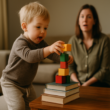If you’ve ever felt like your baby is practically glued to you, you’re not alone—welcome to the world of the “velcro baby.”
I wish more parents had been honest with us about the possibility of a Velcro baby when I was pregnant. They told us we would be tired, cranky with each other, and overwhelmed. But it was SO much more than that. Our second son was attached to me for the first six months of his life. I even slept with him tied to me sometimes.
But what is a Velcro baby, you ask?
Velcro babies love to be close, often needing to be held or snuggled constantly. While it can be exhausting, especially when you want a few minutes to yourself, this clinginess is completely normal and something many parents experience. This stage won’t last forever, and it’s an important part of their emotional development. So, while it might be tough, remember that your baby’s clinginess is their way of saying, “I feel safe with you.”

Why Are Some Babies Clingy?
Being your baby’s safe space is all good and well. But that doesn’t mean much when you’ve tried to pee with a baby attached to you!
Some babies are just more clingy than others, and here are some reasons why:

Temperament
Some babies are naturally more sensitive, often making them more prone to clinginess. These babies might be more easily overwhelmed by new environments, loud noises, or even changes in routine. Their heightened sensitivity means they seek constant reassurance from their parents, their safe haven in a world that sometimes feels big and scary. If your baby falls into this category, know that their clinginess is how they cope with their surroundings and find comfort.
Developmental Milestones
Clinginess often spikes during key developmental milestones. As your baby starts learning to crawl, teethe, or walk, they might feel uncertain or uneasy about these big changes. During these times, they turn to you for comfort and security.
It’s their way of saying, “I’m figuring out this new skill, but I still need to know you’re here for me.”
Attachment and Bonding
A clingy baby is often a sign of a strong, secure attachment between you and your child. I know it’s hard, but this bond is essential for their emotional development. When your baby clings to you, it’s because they know you’re their safe place.
Separation Anxiety
Separation anxiety is another common reason for clinginess, particularly around the 6-12 month mark. As babies start to understand that they are separate from their parents, they also realize that you can leave—and that’s when the clinginess can ramp up. During this phase, your baby might cry or become distressed when you leave the room, even for a moment. This anxiety is a normal part of development and typically peaks around one year before gradually fading as they grow older and more independent.
How Long Does the Velcro Baby Stage Last?
The clingy phase often feels like it will last forever, but it usually peaks around 9 to 12 months. During this time, your baby is becoming more aware of the world—and more attached to you—making them extra clingy. While it might feel never-ending, most babies start to outgrow this phase by the time they’re 2 to 3 years old. But remember, even if it feels like you’re carrying a little koala 24/7, this stage is just that—a stage.
No two babies are the same, so the timeline for this clingy phase can vary widely. Some babies might start becoming more independent as they approach their first birthday, while others might need a bit more time and reassurance before they’re ready to let go.
My son was super independent but also crazy clingy. His independence didn’t make him less clingy. He is eight now, still loves a good cuddle, and checks in constantly. It’s perfectly okay if your baby clings to you a little longer—each child moves at their own pace, and there’s no rush. Although my son still checks in, he is independent, and we share a beautiful connection. So, there is a light at the end of the clingy tunnel!

4 Practical Tips for Managing a Clingy Baby
There is no quick fix for a Velcro baby, but there are some tips and tricks you can use to survive them!
1. Routine and Predictability
Babies thrive on routine, and a consistent daily schedule can go a long way in helping your clingy little one feel more secure. When they know what to expect—when it’s time for naps, meals, or play—they feel more in control, which can ease their need for constant reassurance. Try to stick to a predictable routine, especially during times of transition, like before naps or bedtime. This stability can give them the comfort of knowing you’ll be there, even if you’re not right by their side every second.
2. Comfort Objects
Introducing a comfort object, like a soft toy or blanket, can offer your baby a sense of security when you’re not immediately available. Some people don’t love the idea of their child being dependent on something for comfort, but it has been a game changer with both my kids. Having something to snuggle can help soothe their anxiety and give them a little extra courage to explore without clinging as much.

3. Babywearing
Babywearing is a game-changer for parents of clingy babies, and I wouldn’t have made it through early motherhood without it. It lets you keep your baby close while allowing you to tackle your to-do list with both hands. I returned to work after six weeks, and babywearing allowed me to run a guest lodge (and running after a toddler) without losing my mind.
Whether you’re cooking, folding laundry, or just trying to have a moment of peace, wearing your baby in a carrier gives them the closeness they crave while giving you a little more flexibility. Plus, it keeps them calm while you get things done.
4. Gradual Separation
Separation doesn’t have to happen all at once. You can start by introducing short periods to help with separation anxiety (and help you overcome the inevitable mom guilt). For example, leave the room for a minute and return with a smile, showing them that you’re not gone forever. Gradually increase the time you’re away, reassuring them with your voice if they become distressed. It’s all about baby steps—both for them and for you!
Self-Care for Parents: Surviving the Velcro Baby Stage

Thinking about self-care when you constantly have a baby attached to you can feel impossible. I remember getting so frustrated when people said, “Look after yourself” or “Make time for yourself.”
But now that I’m out of the baby stage, I can look back and see that they were right. I was an angry mom for those first few years. I didn’t prioritize my needs, and I wasn’t taking care of my mental health. Two under two broke me. Don’t let it do the same to you.
“You’ll learn to lower your expectations about what you can accomplish in a day. Some days, it will be all you can do to keep a baby safe, warm, and fed, and that will be enough.”
– Unknown
Patience and Perspective
In the thick of it, the velcro baby stage can feel never-ending. It’s easy to get worn down, but try to keep in mind that this phase, as tough as it is, is temporary. Your baby’s need for constant closeness is a normal part of their development, and it’s helping them grow into a secure and confident little person. Take a deep breath and remind yourself that this is just one stage of many—one that will eventually pass.
Seek Support
Ask for help! Whether it’s a partner, a grandparent, or a trusted friend, sometimes just having someone else step in, even for a few minutes, can make all the difference. If family and friends aren’t nearby, parenting groups—either in person or online—can be a great way to connect with others who understand exactly what you’re going through. Sometimes, just knowing you’re not alone can make a big difference.
Take Breaks
It’s easy to get caught up in caring for your baby 24/7, but your own well-being is just as important. Carve out small moments for yourself, even if it’s just sipping a hot cup of anything (a seriously underrated self-care hack), taking a five-minute walk, or catching a quiet breath while your baby naps. These little pockets of self-care help you recharge so you can come back to your baby feeling more balanced and ready to handle the demands of the day.
Celebrate Small Wins
On tough days, it’s easy to focus on how exhausting it all is, but don’t forget to acknowledge the small victories. Did your baby play on their own for a few minutes? Did they show interest in a new toy? These little moments are signs of progress. Celebrate them—because even tiny steps forward mean you’re both moving in the right direction.
Embracing the Clingy Stage

It’s easy to get caught up in the exhaustion and overwhelm that comes with having a velcro baby. I get; I’ve been there. I don’t have much advice for you because each baby is different. But one thing that helped me survive the day-to-day madness of a clingy baby was soaking up the small moments.
- Cherishing the Closeness: It might feel overwhelming at times, but this clingy phase is also filled with extra snuggles and closeness that won’t last forever. As tough as it can be, try to pause and appreciate these cuddly moments—they’re fleeting, and one day, you might miss having a little one who needs you this much.
- Trust Your Instincts: Every parent knows their baby best, and no one-size-fits-all solution will work for every family. Trust your instincts when figuring out what soothes your baby or what routines make them feel most secure. Whether it’s wearing your baby in a sling all day or taking those little moments for gradual separation, your intuition will guide you in finding the best balance for your family. If it feels right, it probably is.
- Focus on the Positives: This stage helps foster a secure attachment, which will benefit your baby in the long run. A strong, healthy bond now sets the foundation for your child’s emotional security as they grow. Focus on the positives, knowing that all the closeness and extra love is building their confidence and trust in the world.
Final Thoughts on Your Velcro Baby
There’s no way around it: a clingy baby is HARD! But your velcro baby knows that your arms are the best place to be, and who can blame them? You are their whole world.
So, the next time your baby hangs on for dear life, take an extra sniff of that delicious baby scent and lean in. You’ve got this!
PS. If you have any velcro baby hints and tips, drop them in the comments below. It might just help another mama out.











